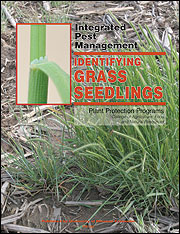
In any integrated pest management program, the first logical step is to recognize the pest. Control measures depend upon accurate identification. Grasses occurring as weeds are difficult to identify in their vegetative stages, particularly in the one- to two-leaf seedling stage of growth. At this stage, you often need to identify the grass to make important management decisions. Many grasses do not flower until late in the growing season, after they have already had an impact on crop yields.
Accurate identification is also important in the early growth stages because smaller grasses are easier to control with conventional management tactics than larger grasses. Smaller grass seedlings are more susceptible to lower dosages of herbicides, and thus greater control can be achieved while minimizing control costs.
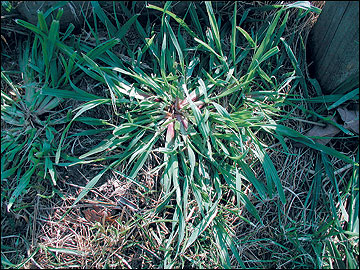 Figure 1
Figure 1
Yellow foxtail has flat stems.
Principles of weed identification
Several obvious features help you narrow the list of potential species when identifying a grass plant. First, consider the life cycle. Because some grasses are not present at certain times of the year, these can quickly be eliminated from the list. For example, you would not expect to encounter a warm-season annual grass, such as giant foxtail, in March. Likewise, winter annual grasses, such as downy brome, die back with the onset of late spring and early summer temperatures and are not present during the summer months.
The shape of the stem is another feature that is easy to determine. Most grasses have round stems, but several others have distinctly flat stems. Knowing the several common grasses that have flattened stems, you can quickly reduce the list of potential species. Some of the common grasses with flattened stems are barnyardgrass, goosegrass, orchardgrass and yellow foxtail (Figure 1).
If the stem has a triangular shape, the plant is most likely a sedge, not a true grass at all. This is an important determination because management for a grass is much different than management for a sedge. Rate and herbicide selection for control of sedges are much different. Some herbicides that are specifically designed to control grasses have no effect on sedges.
Because grasses have subtle distinguishing characteristics, it is especially important to use a hand or pocket lens with 10× magnification power. Most identifying characteristics are contained in the collar region. The collar region can be seen by carefully pulling the leaf blade back from the stem (Figure 2).
After pulling back the blade, look for the ligule. The ligule, if present, is a small projection that appears as a membrane or a tuft of hair at the base of the leaf blade (Figures 3–4). The hand lens allows you to view this structure and aids in grass identification.
Some grassy weeds have auricles, small fingerlike structures that appear to clasp around the stem at the collar (Figure 5). Common grasses with auricles that can easily be seen include annual and perennial ryegrass and quackgrass. Like broadleaf weeds, grasses vary in the amount and location of hairs on their surfaces (Figures 6–7).
For example, a key difference between large and smooth crabgrass is that large crabgrass is covered with dense hairs while smooth crabgrass has few, if any, hairs.
Another example is the difference between Missouri’s three most common foxtails. Giant foxtail’s upper leaf surface is covered with a dense layer of hair; yellow foxtail has only sparse hairs on the section of the upper leaf blade closest to the main stem; and green foxtail’s upper leaf surface is entirely smooth. The ability to recognize these features will help you accurately identify grass species with the identification key.
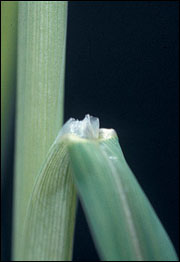
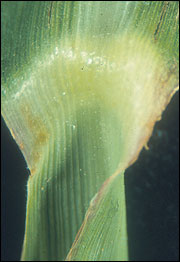 Figure 2
Figure 2
Carefully pull back the blade to reveal the collar region.
Figure 3
No ligule.
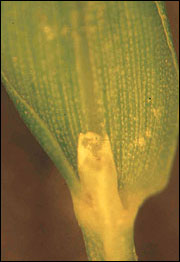
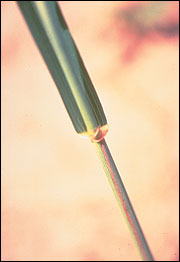 Figure 4
Figure 4
Membranous ligule.
Figure 5
Auricles clasp around stems.
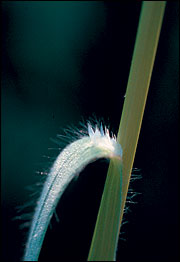
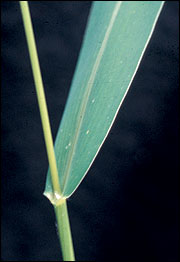 Figure 6
Figure 6
Densely hairy grass plant.
Figure 7
Smooth leaf blade surface.
Weed identification
This publication is designed to assist those in agricultural and horticultural settings to identify grassy weed species. The following photographs and written descriptions will help you compare your samples for positive identification. The photographs help compare characteristics of grass species at immature as well as mature stages of growth. For effective management, positive identification of any pest, including weeds, is paramount.
Glossary
- Acute membrane
A ligule terminated with a pointlike appearance. - Annual
Plants that complete their growth from seed to maturity within one growing season. For example, summer annuals germinate in the spring and complete their growth in late summer to early fall; winter annuals germinate in the fall or late winter and complete their growth in the spring to early summer. - Auricles
Small appendages that project from the base of the leaf blade and appear to wrap, at least partially, around the grass stem. - Awns
Bristles that arise from the spikelet. - Blade
Part of the grass plant that is above the sheath; the expanded portion of the leaf. - Bud
An undeveloped leaf or flower. - Clump-forming
A single grass plant that has few to many stems arising from the same point. - Collar
Junction of grass blade and sheath. - Compressed
Flat, as in the sheaths of some grasses. - Decumbent
Reclining or lying on the ground but with the tips ascending. - Life cycle
The length of season to complete a plant’s growth. For example, annuals complete their growth within one season; biennials, two seasons; and perennials, more than two seasons. - Ligule
A projection at the base of the leaf blade on most grasses; it may be either membranous or a tuft of hair. - Midvein
The central or main rib of a leaf. - Node
On the stem, a joint or knot that bears leaves. - Perennial
Life cycle that requires more than two seasons to complete. - Rhizome
Creeping underground stem that usually produces roots and shoots at its nodes. - Rolled
Grass leafbud that appears wrapped around and around. - Sedge
Plant that is not a true grass but has triangular-shaped stems and leaf blades. - Sheath
The lower part of the leaf blade that encircles the stem and younger leaves. - Stolon
Creeping stem above the soil surface; it produces roots at its nodes and gives rise to new plants at its tips.
Written by Fred Fishel and Kevin Bradley Division of Plant Sciences